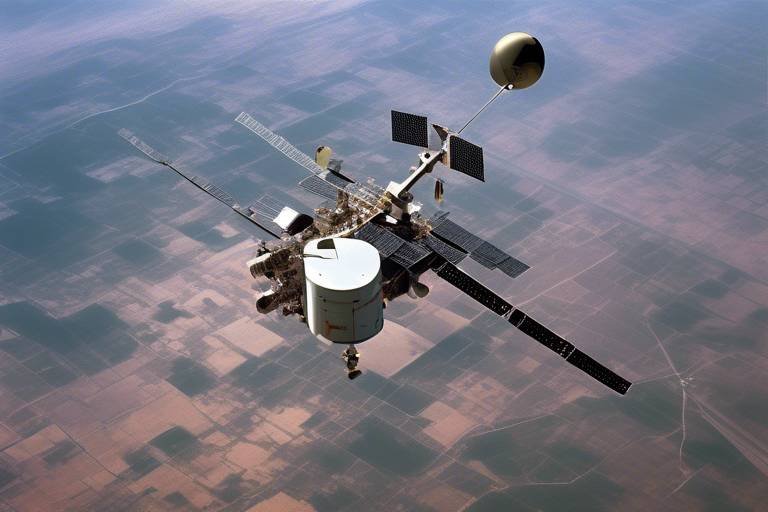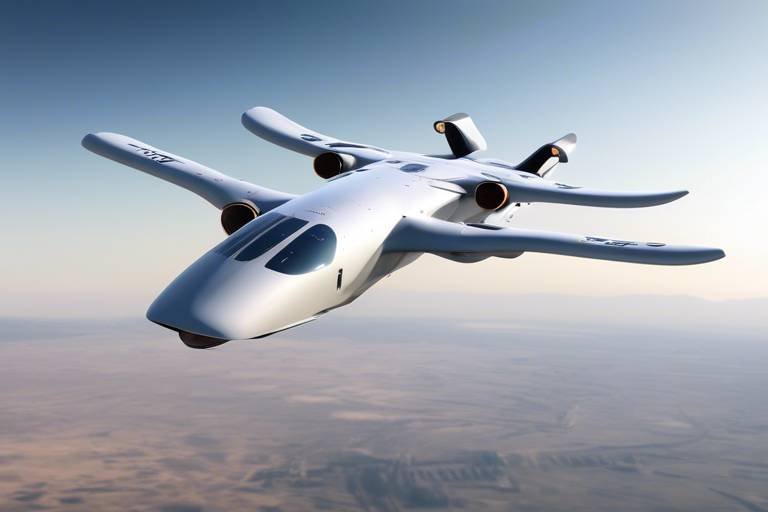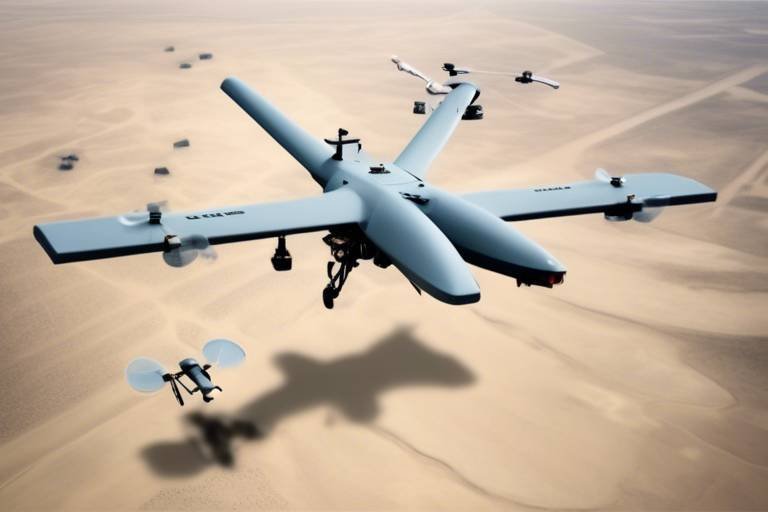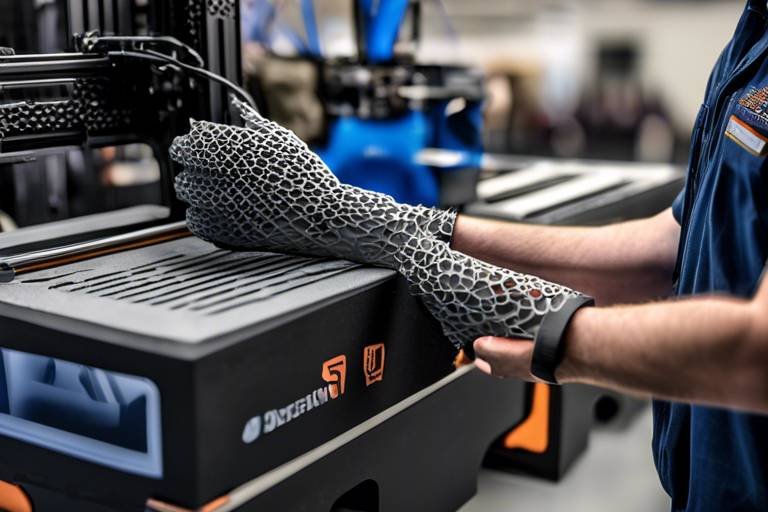Innovations in Submarine Technology for 2025 and Beyond
As we dive into the future of underwater exploration, the realm of submarine technology is undergoing a transformative revolution. With the year 2025 on the horizon, we are witnessing a surge in groundbreaking advancements that promise not only to enhance the capabilities of submarines but also to ensure their sustainability and operational efficiency. Imagine a world where submarines can navigate the depths of the ocean with unparalleled speed, stealth, and intelligence. This is not just a dream—it's becoming a reality. The innovations we explore in this article will reshape how we think about underwater defense and exploration, making it more efficient, eco-friendly, and technologically advanced.
Submarines have long been the silent guardians of the seas, yet the challenges they face are evolving. As geopolitical tensions rise and environmental concerns become more prominent, the need for advanced technology in underwater vessels is more critical than ever. From propulsion systems that promise to redefine speed and stealth to sonar technologies that offer a tactical edge in complex environments, the innovations are truly astounding. Moreover, the integration of artificial intelligence and machine learning is set to revolutionize how submarines operate, making them smarter and more responsive than ever before.
But it doesn't stop there. The future of submarine technology also emphasizes sustainability. With growing awareness of our ecological footprint, the industry is shifting towards more eco-friendly materials and designs that minimize environmental impact. This approach not only aligns with global sustainability goals but also enhances the performance and longevity of these vessels. In this article, we will explore various facets of submarine innovations, highlighting how they are set to change the landscape of underwater missions.
What does the future hold for submarines? Will they become even more autonomous and capable of operating in tandem with unmanned vehicles? How will cybersecurity measures evolve to protect these sophisticated machines? As we delve deeper into each section, we will uncover the answers to these questions and more, revealing a future where submarines are not just tools of defense but also champions of exploration and sustainability.
- What are the main advancements in submarine technology expected by 2025?
Expect innovations in propulsion systems, sonar technology, stealth capabilities, and sustainability measures. - How does artificial intelligence enhance submarine operations?
AI improves real-time data analysis, threat detection, and decision-making, making submarines more efficient and effective. - What role do autonomous underwater vehicles play in future submarine missions?
AUVs enhance reconnaissance and data collection, working alongside manned submarines for improved mission success. - Why is sustainability important in submarine design?
Sustainability reduces ecological impact, aligning with global environmental goals while maintaining operational effectiveness. - What cybersecurity measures are being implemented in submarine technology?
Advanced threat detection systems are crucial for safeguarding sensitive data and ensuring the operational integrity of submarines.

Advanced Propulsion Systems
This article explores groundbreaking advancements in submarine technology, focusing on innovations that enhance capabilities, sustainability, and operational efficiency for the future of underwater exploration and defense.
The evolution of propulsion technologies is crucial for enhancing submarine speed and stealth. Imagine a submarine gliding silently beneath the waves, its presence undetectable while it travels at unprecedented speeds. This is the future we are heading towards, thanks to groundbreaking advancements in propulsion systems. The latest developments in nuclear propulsion and alternative energy sources are set to revolutionize underwater travel, making submarines not only faster but also more efficient and environmentally friendly.
One of the most exciting innovations in submarine propulsion is the integration of liquid metal batteries. Unlike traditional batteries, these new power sources offer high energy density and longer lifespans, which are crucial for long-duration missions. Additionally, they can operate in extreme conditions, making them ideal for the challenging underwater environment. With the ability to recharge quickly and sustain power for extended periods, these batteries could significantly enhance a submarine's operational capabilities.
Moreover, the development of hybrid propulsion systems is gaining traction. These systems combine conventional diesel engines with electric motors, allowing submarines to operate quietly and efficiently when submerged. The flexibility of switching between power sources means that submarines can optimize their performance based on mission requirements. For instance, during stealth operations, they can rely on electric propulsion, while diesel engines can be used for high-speed travel on the surface. This adaptability not only enhances tactical advantages but also contributes to fuel efficiency and reduced emissions.
Another fascinating area of research is the use of bio-inspired propulsion systems. By mimicking the movements of marine animals, engineers are developing new designs that reduce drag and increase speed. For example, some submarines may incorporate fins that mimic the flapping motion of fish, allowing for smoother navigation through the water. This biomimicry could lead to submarines that are not only faster but also more maneuverable, making them harder to detect and track.
The future of submarine propulsion is undoubtedly exciting, with innovations that promise to enhance speed, stealth, and operational efficiency. As we look ahead to 2025 and beyond, these advancements will redefine underwater exploration and defense, ensuring that submarines remain at the forefront of military and scientific capabilities.
- What are the main types of propulsion systems used in submarines?
Submarines primarily use nuclear propulsion and diesel-electric systems, with emerging technologies including hybrid and bio-inspired systems. - How do advanced propulsion systems improve submarine stealth?
Advanced systems reduce noise and vibrations, making submarines less detectable while allowing for quieter operations. - What are liquid metal batteries and why are they important?
Liquid metal batteries offer high energy density and longevity, making them ideal for powering submarines during long missions.

Enhanced Sonar and Detection Technologies
In the ever-evolving world of underwater warfare and exploration, are at the forefront of innovation. Modern submarines are increasingly reliant on sophisticated sonar systems that not only aid in navigation but also play a crucial role in threat detection. Imagine the underwater realm as a vast, dark ocean where visibility is limited, and dangers lurk around every corner. This is where advanced sonar technologies shine, providing submarines with the ability to "see" their surroundings through sound waves. These systems have undergone significant transformations, leading to improved accuracy, range, and overall operational effectiveness.
One of the most exciting developments in sonar technology is the integration of artificial intelligence (AI). AI is revolutionizing how submarines interpret sonar data, enabling real-time analysis and decision-making. Picture a submarine navigating through murky waters, its AI-powered sonar system processing countless data points in seconds to identify potential threats. This capability allows submarines to react swiftly to changing environments, enhancing their tactical advantage in various scenarios.
Artificial intelligence is not just a buzzword; it's a game-changer for sonar capabilities. By employing machine learning algorithms, submarines can enhance their target recognition and threat assessment processes. These algorithms are designed to adapt to different underwater acoustics, making them more effective in detecting submarines, mines, and other underwater objects. The result? A more reliable and efficient sonar system that significantly increases the chances of mission success.
Machine learning algorithms are the backbone of modern sonar systems. They learn from past experiences and continuously improve their detection rates. For example, if a submarine encounters a new type of underwater object, the machine learning algorithm analyzes the acoustic signature and adjusts its parameters to better recognize similar objects in the future. This adaptability is crucial in the unpredictable underwater environment, where conditions can change rapidly.
Another groundbreaking advancement in sonar technology is the implementation of data fusion techniques. These techniques combine inputs from various sensors—such as sonar, radar, and optical systems—to create a comprehensive underwater picture. Think of it as piecing together a jigsaw puzzle; each sensor provides a piece of the overall image, allowing submarines to achieve enhanced situational awareness. By integrating data from multiple sources, submarines can better assess the threats they face and make informed decisions.
To summarize, enhanced sonar and detection technologies are reshaping the landscape of underwater operations. With the integration of AI, machine learning, and data fusion techniques, submarines are becoming more adept at navigating complex underwater environments. These innovations not only improve the efficiency of submarine missions but also ensure that they remain a formidable force in both exploration and defense.
- What is sonar technology? Sonar technology uses sound waves to detect and locate objects underwater. It is essential for navigation and threat detection in submarines.
- How does artificial intelligence improve sonar systems? AI enhances sonar systems by enabling real-time data analysis, improving target recognition, and adapting to different underwater acoustics.
- What are data fusion techniques? Data fusion techniques integrate information from multiple sensors to create a more comprehensive understanding of the underwater environment.
- Why is machine learning important for submarines? Machine learning allows sonar systems to learn from past experiences, improving their detection capabilities and adaptability to changing conditions.

Artificial Intelligence in Sonar
In the world of modern warfare and underwater exploration, the integration of Artificial Intelligence (AI) into sonar technology is nothing short of revolutionary. Imagine a submarine that can not only detect threats but also analyze and interpret sonar data in real-time, making split-second decisions that could mean the difference between success and failure in a mission. This is the power of AI in sonar systems, and it's changing the game for naval operations.
Traditionally, sonar technology relied heavily on human operators to interpret the data collected from underwater environments. However, with the advent of AI, this process is becoming increasingly automated. AI algorithms can process vast amounts of sonar data much faster than a human ever could, identifying patterns and anomalies that might go unnoticed. This capability not only enhances target recognition but also improves threat assessment in complex underwater scenarios.
One of the most exciting aspects of AI in sonar is its ability to learn and adapt. Through machine learning, these systems can continuously improve their detection capabilities by analyzing previous encounters and outcomes. For instance, if a submarine encounters a new type of underwater object, the AI can learn from that experience, refining its algorithms to better identify similar objects in the future. This is akin to how humans learn from experience, but at a much faster pace and with far greater accuracy.
Furthermore, AI enhances the effectiveness of sonar systems through data fusion techniques. By combining inputs from multiple sensors—such as sonar, radar, and even satellite data—AI can create a comprehensive picture of the underwater environment. This holistic view is crucial for submarines operating in contested waters, where understanding the full spectrum of potential threats is essential for survival and mission success.
To illustrate the impact of AI on sonar technology, consider the following table that highlights key benefits:
| Benefit | Description |
|---|---|
| Real-Time Analysis | AI processes sonar data instantly, allowing for immediate decision-making. |
| Increased Accuracy | Machine learning algorithms improve detection rates and reduce false positives. |
| Adaptive Learning | AI systems learn from past encounters to enhance future performance. |
| Comprehensive Situational Awareness | Data fusion techniques provide a complete understanding of the underwater environment. |
As we move towards 2025 and beyond, the role of AI in sonar technology will only continue to expand. The potential for enhanced operational efficiency, improved safety, and greater tactical advantages is immense. With AI at the helm, submarines will be better equipped to navigate the challenges of modern warfare, ensuring they remain a vital component of naval power.
- How does AI improve sonar detection? AI enhances sonar detection by processing data faster and more accurately than human operators, identifying patterns and anomalies in real-time.
- What is machine learning in sonar systems? Machine learning allows sonar systems to learn from past experiences, improving their detection capabilities over time.
- Why is data fusion important for submarines? Data fusion combines information from various sensors, providing a comprehensive view of the underwater environment and enhancing situational awareness.

Machine Learning Algorithms
In the realm of submarine technology, are emerging as game-changers, significantly enhancing the capabilities of sonar systems. These algorithms utilize vast amounts of underwater acoustic data to improve detection rates and target identification. Imagine a submarine equipped with a brain that learns from every sound it hears, adapting its responses based on previous experiences. This is precisely what machine learning brings to the table.
One of the most remarkable aspects of these algorithms is their ability to adapt to varying underwater environments. Different bodies of water present unique acoustic challenges, such as temperature layers, salinity, and background noise. By employing machine learning, submarines can adjust their detection methods in real-time, ensuring that they remain effective regardless of the conditions. For instance, when operating in a noisy environment, the algorithm can filter out irrelevant sounds, focusing on potential threats.
Furthermore, the integration of machine learning allows for a more efficient processing of data. Traditional sonar systems often rely on pre-programmed responses, which can limit their effectiveness in dynamic situations. In contrast, machine learning algorithms can analyze incoming data streams, identifying patterns and anomalies that human operators might miss. This capability not only improves target recognition but also enhances the overall situational awareness of submarine crews.
To illustrate this, consider the following table, which outlines the key benefits of implementing machine learning algorithms in submarine sonar systems:
| Benefit | Description |
|---|---|
| Adaptive Learning | Algorithms improve over time, learning from new data to enhance detection accuracy. |
| Real-Time Analysis | Instant processing of sonar data allows for immediate threat assessment. |
| Noise Filtering | Ability to distinguish between significant sounds and background noise. |
| Pattern Recognition | Identifies trends and anomalies in underwater acoustics for better decision-making. |
As we look to the future, the role of machine learning in submarine technology will only continue to grow. With advancements in computational power and data collection methods, we can expect even more sophisticated algorithms that will redefine how submarines operate in complex underwater environments. The potential for improved safety, efficiency, and operational success is immense, making machine learning a cornerstone of next-generation submarine capabilities.
- What are machine learning algorithms?
Machine learning algorithms are computational methods that enable systems to learn from data and improve their performance over time without being explicitly programmed. - How do these algorithms enhance submarine technology?
They enhance submarine technology by improving sonar detection rates, adapting to various underwater conditions, and providing real-time data analysis for better decision-making. - Are machine learning algorithms used in other military applications?
Yes, machine learning algorithms are increasingly being utilized in various military applications, including drone navigation, threat detection, and battlefield management. - What challenges do machine learning algorithms face in underwater environments?
Challenges include dealing with noise interference, varying acoustic conditions, and the need for large datasets for effective training.

Data Fusion Techniques
In the ever-evolving realm of submarine technology, play a pivotal role in enhancing operational effectiveness and situational awareness. By integrating data from various sensors, submarines can create a comprehensive and accurate representation of their underwater environment. Imagine being in a dense fog, unable to see beyond a few feet; now, think of how different it would be if you had a high-tech radar system that painted a clear picture of everything around you. That's what data fusion does for submarines—it removes the fog of uncertainty.
At the heart of these techniques lies the ability to combine inputs from multiple sources, such as sonar, radar, and other electronic systems. This amalgamation of data allows submarines to assess threats more accurately, navigate challenging terrains, and make informed decisions in real-time. For instance, a submarine equipped with advanced data fusion systems can analyze sonar data alongside visual imagery from underwater cameras, creating a layered understanding of its surroundings.
Moreover, the integration of machine learning algorithms into data fusion processes enhances the system's capability to adapt to dynamic underwater conditions. These algorithms learn from past encounters, continuously improving their ability to filter out noise and focus on relevant signals. This adaptability is crucial, especially in environments where traditional sensors might struggle to provide clear information.
To illustrate the effectiveness of data fusion techniques, consider the following table that outlines the benefits of integrating various data sources:
| Data Source | Benefit |
|---|---|
| Sonar | Provides detailed information on underwater objects and terrain. |
| Radar | Detects surface vessels and aerial threats. |
| Visual Sensors | Offers real-time imagery for identification and assessment. |
| Environmental Sensors | Monitors water temperature, salinity, and currents for improved navigation. |
In conclusion, the implementation of data fusion techniques is not just a technological upgrade; it is a game-changer for submarine operations. By synthesizing data from diverse sources, submarines can achieve a holistic view of their environment, thereby enhancing their ability to operate stealthily and effectively. As we move towards 2025 and beyond, the reliance on these sophisticated systems will undoubtedly increase, enabling submarines to navigate the complexities of underwater warfare and exploration with unprecedented precision.
- What are data fusion techniques?
Data fusion techniques involve integrating data from multiple sensors to create a comprehensive understanding of an environment, enhancing decision-making and situational awareness. - How do machine learning algorithms improve data fusion?
Machine learning algorithms adapt to changing conditions and learn from past data, improving the accuracy and efficiency of data fusion processes. - Why is data fusion important for submarines?
Data fusion is critical for submarines as it enhances their ability to detect threats, navigate effectively, and operate stealthily in complex underwater environments.

Next-Generation Torpedoes
The realm of torpedo technology is undergoing a remarkable transformation, paving the way for that promise to redefine naval warfare. These advanced weapons are not just about brute force; they are engineered with precision, stealth, and intelligence, making them formidable assets in any underwater engagement. Imagine a torpedo that can not only navigate through hostile waters but also adapt its strategy based on real-time environmental data. This is the future we're looking at, and it's nothing short of revolutionary.
One of the most exciting advancements in torpedo design is the integration of smart guidance systems. These systems utilize a combination of GPS, sonar, and advanced algorithms to enhance targeting accuracy. Unlike traditional torpedoes that follow a pre-set path, next-generation models can adjust their trajectories mid-flight, allowing them to evade countermeasures and home in on their targets with pinpoint precision. This adaptability is crucial in modern naval warfare, where the element of surprise can be the difference between victory and defeat.
In addition to their guidance systems, these torpedoes are being designed with advanced propulsion technologies. Electric and hybrid propulsion systems are increasingly common, providing longer ranges and quieter operations. This means that submarines can launch their torpedoes from greater distances without revealing their position. The stealthy nature of these torpedoes is further enhanced by noise reduction techniques that minimize sound emissions, making them nearly undetectable until it's too late for the enemy.
Moreover, next-generation torpedoes are equipped with sophisticated data processing capabilities. This allows them to analyze the underwater environment and make real-time decisions based on changing conditions. For instance, if a target suddenly changes course or speed, the torpedo can recalibrate its approach to ensure a successful hit. This level of intelligence is akin to having a tactical advisor onboard, making these weapons not just tools of destruction but also strategic assets.
To give you a clearer picture of these advancements, let's take a look at some key features of next-generation torpedoes in the table below:
| Feature | Description |
|---|---|
| Smart Guidance Systems | Utilizes GPS, sonar, and algorithms for real-time targeting adjustments. |
| Advanced Propulsion | Electric and hybrid systems for longer range and stealthy operations. |
| Data Processing | Real-time analysis of underwater conditions for adaptive targeting. |
| Stealth Technology | Noise reduction techniques to minimize detection risk. |
As we look to the future, the development of next-generation torpedoes is not just about enhancing offensive capabilities; it's also about ensuring the safety and effectiveness of naval forces. With the potential to engage threats from a distance, these torpedoes enable submarines to operate more safely while still maintaining a formidable presence in the underwater theater. The combination of advanced technology, intelligence, and stealth is setting the stage for a new era in naval warfare, where the balance of power will be determined by those who can harness these innovations effectively.
- What makes next-generation torpedoes different from traditional ones?
Next-generation torpedoes incorporate advanced guidance systems, propulsion technologies, and real-time data processing capabilities, enabling them to adapt to changing conditions and enhance targeting accuracy. - How do smart guidance systems work?
They use a combination of GPS, sonar, and algorithms to allow the torpedoes to adjust their paths mid-flight, making them more effective against evasive targets. - Are next-generation torpedoes quieter?
Yes, they are designed with noise reduction technologies that minimize sound emissions, making them harder to detect before they strike. - What role do these torpedoes play in modern naval warfare?
They enhance the offensive capabilities of submarines while allowing them to operate more safely, thus changing the dynamics of underwater engagements.

Stealth Technologies
In the world of modern warfare, the element of stealth is not just an advantage; it’s a necessity. Submarines, the silent guardians of the deep, rely heavily on advanced technologies to remain undetected. As we look towards 2025 and beyond, innovations in stealth technologies are set to redefine the capabilities of submarines, ensuring they can operate effectively in contested environments without drawing attention. Imagine a predator that moves through the water like a ghost, unseen and unheard—this is the future of submarine design.
One of the most significant advancements in stealth technology is the development of new materials that can absorb sound and minimize radar signatures. These materials are engineered to disrupt the sound waves that submarines naturally produce, effectively rendering them invisible to enemy sonar systems. For instance, the use of anechoic coatings on the hulls of submarines can significantly reduce their acoustic signature. This advancement is akin to wrapping a gift in layers of soundproof wrapping paper, ensuring that the contents remain a mystery.
Furthermore, innovations in hull design are playing a crucial role in enhancing stealth. Modern submarines are being designed with streamlined shapes that reduce drag and turbulence, which in turn minimizes the noise generated during movement. The combination of these design elements creates a vessel that can glide through the water with the elegance of a dolphin, virtually undetectable to the keenest eyes and ears.
To illustrate the effectiveness of these stealth technologies, consider the following table that compares traditional submarine designs with the next-generation stealth submarines:
| Feature | Traditional Submarine | Next-Generation Stealth Submarine |
|---|---|---|
| Noise Signature | High | Low |
| Radar Visibility | Moderate | Minimal |
| Hull Design | Conventional | Streamlined and Coated |
| Operational Range | Limited | Extended |
Another critical aspect of stealth is the noise reduction techniques being developed for submarine machinery. Traditional engines and propellers can create significant underwater noise, which can easily give away a submarine's position. However, advancements in electric propulsion systems and quieter machinery are changing the game. These systems operate with much less noise, allowing submarines to approach their targets with the stealth of a shadow. Think of it like switching from a loud motorcycle to a silent electric bike—both can get you where you need to go, but one does it without waking the neighborhood.
In conclusion, the future of submarine stealth technologies is not just about avoiding detection; it’s about ensuring that submarines can perform their missions effectively while remaining invisible to adversaries. As these technologies evolve, submarines will become even more formidable, capable of engaging in complex operations without the fear of being discovered. The silent warriors of the deep are gearing up for a new era, and the innovations in stealth technology are at the forefront of this transformation.
- What are the main technologies used for submarine stealth?
Submarine stealth technologies include advanced materials that absorb sound, innovative hull designs, noise reduction techniques, and electric propulsion systems.
- How do anechoic coatings work?
Anechoic coatings are specialized materials applied to submarine hulls that help to reduce sound emissions by absorbing sound waves, making the submarine harder to detect.
- Why is stealth important for submarines?
Stealth is crucial for submarines as it allows them to operate undetected, providing a tactical advantage during military operations and ensuring the safety of the crew and vessel.

Noise Reduction Techniques
In the realm of submarine technology, noise reduction is not just a feature; it’s a necessity. As submarines operate in an environment where sound travels far and wide, the ability to minimize noise emissions can be the difference between evasion and detection. Innovations in this field are akin to crafting a whisper in a roaring storm, allowing submarines to navigate stealthily through the depths of the ocean. The latest advancements focus on a combination of hull design improvements, advanced materials, and innovative machinery that work together to create a quieter underwater profile.
One of the most significant strides in noise reduction comes from the evolution of hull designs. Modern submarines are increasingly utilizing anechoic coatings, which are specially formulated materials that absorb sound waves rather than reflect them. Think of these coatings as soundproofing for submarines, akin to the way a music studio is designed to keep noise in and outside sounds out. The application of these materials helps to dampen the vibrations generated by the submarine’s movement through water, allowing it to glide silently.
Furthermore, advancements in propulsion systems have led to the development of quieter engines. Traditional propellers are being replaced with more sophisticated designs that reduce cavitation—a phenomenon that produces significant noise as bubbles collapse in turbulent water. By employing advanced rotor designs and electric propulsion systems, submarines can now achieve greater efficiency while significantly lowering their acoustic signatures. This is akin to switching from a loud, clunky old car to a sleek, quiet electric vehicle that glides effortlessly down the road.
Another critical aspect of noise reduction is the engineering of submarine machinery. Innovations in vibration isolation techniques are being adopted to minimize the sound generated by onboard systems. By employing flexible mounts and sound-dampening materials, submarines can effectively isolate vibrations from engines and pumps, reducing the overall noise produced. This method is similar to how a well-insulated home keeps outside noise at bay, creating a peaceful environment inside.
In addition to these technological advancements, submarines are increasingly utilizing advanced computational models to simulate and analyze noise propagation. These models allow engineers to predict how sound behaves in various underwater environments and refine designs accordingly. This proactive approach ensures that submarines can maintain their stealth capabilities in different operational scenarios, much like a chess player who anticipates their opponent's moves ahead of time.
Overall, the integration of these noise reduction techniques represents a critical evolution in submarine technology. As the stakes in underwater operations continue to rise, the ability to remain undetected will be paramount. Through innovative hull designs, quieter propulsion systems, and advanced machinery, the future of submarines looks not just stealthy but also incredibly promising.
- What are the main techniques used for noise reduction in submarines?
The primary techniques include advanced hull designs with anechoic coatings, quieter propulsion systems, and vibration isolation methods for machinery. - How does noise reduction impact submarine operations?
Noise reduction enhances stealth capabilities, allowing submarines to operate undetected, which is crucial for both military and research missions. - Are there any new materials being used for noise reduction?
Yes, new anechoic coatings and sound-dampening materials are being developed to absorb sound and minimize vibrations. - Why is stealth important for submarines?
Stealth is critical for avoiding detection by enemy forces and for conducting covert operations without revealing the submarine's position.

Autonomous Underwater Vehicles (AUVs)
In recent years, have emerged as game-changers in the realm of underwater exploration and military operations. These sophisticated machines are not just tools; they represent a leap into the future of naval capabilities. Imagine sending a small, robotic submarine into the depths of the ocean to gather data or conduct reconnaissance without putting human lives at risk. That's the beauty of AUVs—they can dive deep into hostile environments, explore uncharted territories, and collect crucial information while remaining undetected.
The integration of AUVs with manned submarines is revolutionizing how underwater missions are conducted. AUVs can be deployed to perform tasks such as surveillance, reconnaissance, and data collection, extending the operational reach of traditional submarines. By taking on the more dangerous tasks, AUVs allow crewed vessels to focus on strategic operations, enhancing overall mission efficiency. Picture a scenario where a manned submarine launches an AUV to scout a potentially hostile area. The AUV can gather real-time data, assess threats, and communicate findings back to the crew, all while staying out of harm's way. This synergy is not just a convenience; it can be a matter of life and death.
Moreover, AUVs are equipped with advanced sensors and mapping technologies that enable them to navigate complex underwater environments. They can operate autonomously, following pre-programmed routes or adapting to real-time conditions. This adaptability is crucial, especially in unpredictable underwater landscapes where obstacles and threats can arise suddenly. The data collected by AUVs can be invaluable, providing insights into marine ecosystems, geological formations, and potential threats to national security.
One of the most exciting aspects of AUV technology is its potential for collaborative operations with manned submarines. As these vehicles become more integrated into naval strategies, the results could redefine how missions are executed. For instance, AUVs could be used to create a detailed underwater map before a manned submarine enters an area, ensuring that the crew is fully informed about the environment they are about to navigate. This collaborative approach not only enhances safety but also improves the efficiency of operations, allowing naval forces to achieve their objectives with greater precision.
To illustrate the capabilities and roles of AUVs in modern naval operations, consider the following table:
| Feature | Description |
|---|---|
| Autonomy | AUVs can operate independently, following pre-set missions or adapting to real-time conditions. |
| Data Collection | Equipped with advanced sensors, AUVs gather critical data on underwater environments. |
| Stealth Operations | Due to their size and design, AUVs can operate undetected in hostile waters. |
| Collaboration | AUVs can work alongside manned submarines to enhance mission effectiveness. |
In conclusion, the rise of Autonomous Underwater Vehicles marks a significant shift in submarine technology. They not only enhance the capabilities of naval forces but also pave the way for safer and more efficient underwater missions. As we look to the future, the continued development and integration of AUVs into naval operations will undoubtedly shape the landscape of underwater exploration and defense.
- What are AUVs used for? AUVs are primarily used for underwater exploration, reconnaissance, data collection, and surveillance, often in environments that are too dangerous for manned submarines.
- How do AUVs navigate underwater? AUVs use a combination of pre-programmed routes and real-time data from their sensors to navigate complex underwater terrains.
- Are AUVs autonomous? Yes, AUVs are designed to operate independently, following their programmed missions without the need for direct human control.
- Can AUVs communicate with manned submarines? Absolutely! AUVs can relay data back to crewed vessels in real-time, enhancing situational awareness and operational effectiveness.

Collaborative Operations with Manned Submarines
The integration of Autonomous Underwater Vehicles (AUVs) with manned submarines represents a significant leap forward in naval operations. Imagine a scenario where a human crew, operating a traditional submarine, collaborates seamlessly with an AUV, each complementing the other's strengths. This partnership not only enhances the efficiency of missions but also expands the operational capabilities of submarines in ways previously thought impossible. By deploying AUVs for reconnaissance and surveillance tasks, manned submarines can focus on strategic operations, thereby maximizing their effectiveness.
One of the most exciting aspects of this collaboration is the ability for AUVs to venture into environments that may be too risky for manned vessels. For instance, AUVs can explore shallow waters, navigate through complex underwater terrains, or even carry out missions in contested areas where stealth is paramount. This capability allows submarines to gather vital intelligence without exposing their crew to unnecessary danger. Furthermore, the AUVs can be equipped with advanced sensors and cameras, providing real-time data that can be relayed back to the manned submarine, creating a comprehensive operational picture.
To ensure that these collaborative operations are effective, several strategies are being developed. These include:
- Communication Protocols: Establishing robust communication links between AUVs and manned submarines is crucial. This allows for the seamless exchange of data and commands, ensuring that both units can operate in harmony.
- Mission Planning: Joint mission planning sessions can help both crews understand their roles and responsibilities. This includes defining objectives, timelines, and contingency plans for unexpected scenarios.
- Training Exercises: Regular training exercises that involve both manned submarines and AUVs can enhance their ability to work together. These exercises help crews become familiar with the capabilities and limitations of their counterparts, fostering a spirit of teamwork.
Moreover, the operational synergy between AUVs and manned submarines can lead to significant advancements in tactical decision-making. With AUVs providing real-time data and situational awareness, commanders aboard manned submarines can make informed decisions quickly, adapting to changing conditions in the underwater environment. This adaptability is crucial in modern warfare, where the ability to respond to threats swiftly can mean the difference between success and failure.
As we look towards the future, the collaborative operations between AUVs and manned submarines are poised to redefine underwater missions. The combination of human intuition and advanced technology creates a powerful force that enhances naval capabilities. Just as birds and fish have evolved to work together in nature, so too will our submarines and AUVs evolve to become more effective partners in the realm of underwater exploration and defense.
- What are Autonomous Underwater Vehicles (AUVs)? AUVs are robotic devices that operate underwater without direct human control. They are equipped with sensors and can perform various tasks such as reconnaissance, surveillance, and data collection.
- How do AUVs enhance the capabilities of manned submarines? AUVs can undertake high-risk missions, gather real-time data, and provide situational awareness, allowing manned submarines to focus on strategic operations.
- What challenges exist in the collaboration between AUVs and manned submarines? Challenges include establishing effective communication protocols, ensuring synchronized mission planning, and training crews to operate together efficiently.
- Are AUVs capable of operating independently? Yes, AUVs can operate independently, but their capabilities are significantly enhanced when they work in tandem with manned submarines.

Sustainability in Submarine Design
As we navigate the waters of the 21st century, the importance of sustainability in submarine design has never been more pressing. With the world facing escalating environmental challenges, the defense industry is stepping up to the plate, striving to innovate while minimizing ecological footprints. Submarines, traditionally seen as symbols of military power, are now evolving into vessels that embrace eco-friendly practices. This shift is not just a trend; it’s a necessity.
One of the most significant advancements in sustainable submarine design is the incorporation of eco-friendly materials. Traditionally, submarines were built using heavy metals and materials that posed environmental hazards during production and disposal. However, manufacturers are now exploring alternatives such as biodegradable composites and recycled materials that reduce the ecological impact without compromising performance. These materials not only enhance the submarines' operational capabilities but also contribute to a greener planet.
Moreover, the integration of renewable energy sources is reshaping how submarines operate. For instance, solar panels and advanced battery technologies are being developed to supplement traditional energy sources. This hybrid approach allows submarines to operate more efficiently and reduces their reliance on fossil fuels. Imagine a submarine that can harness solar energy while submerged, significantly extending its operational range and reducing emissions. This is not science fiction; it’s the future of underwater exploration.
Additionally, the focus on energy efficiency is paramount. Submarine designers are increasingly utilizing advanced computational fluid dynamics (CFD) to optimize hull shapes, which leads to reduced drag and improved fuel efficiency. This not only enhances speed and maneuverability but also decreases the overall energy consumption of the vessel. The table below illustrates the potential energy savings achieved through these innovative designs:
| Hull Design Type | Fuel Efficiency Improvement (%) | Operational Range Increase (%) |
|---|---|---|
| Traditional Hull | 0 | 0 |
| Optimized Hull | 15 | 20 |
| Advanced Hydrodynamic Hull | 25 | 30 |
Furthermore, submarines are now equipped with systems designed to reduce waste and promote recycling onboard. Advanced waste management systems allow submarines to process and recycle materials, ensuring that less waste is released into the ocean. This commitment to waste reduction not only protects marine ecosystems but also enhances the submarines' operational sustainability.
As we look ahead, the integration of smart technologies will play a crucial role in sustainable submarine design. By utilizing sensors and data analytics, submarines can monitor their environmental impact in real-time, adjusting operations to minimize ecological footprints. This proactive approach ensures that submarines can operate effectively while being mindful of their surroundings.
In conclusion, the future of submarine design is not just about military prowess; it’s about creating vessels that respect and protect our planet. Through the use of eco-friendly materials, renewable energy sources, and innovative design practices, submarines are becoming champions of sustainability. As we embrace these changes, we can look forward to a future where underwater exploration and environmental stewardship go hand in hand.
- What are eco-friendly materials used in submarine construction? Eco-friendly materials include biodegradable composites and recycled metals that minimize environmental impact.
- How do renewable energy sources benefit submarines? Renewable energy sources, like solar panels, reduce reliance on fossil fuels, enhancing operational efficiency and reducing emissions.
- What role does energy efficiency play in submarine design? Energy efficiency improves fuel consumption, allowing submarines to operate longer ranges with less environmental impact.
- How can submarines monitor their environmental impact? Smart technologies enable real-time monitoring of environmental effects, allowing for adjustments to minimize footprints.

Eco-Friendly Materials
In the face of growing environmental concerns, the submarine industry is taking significant strides toward sustainability. The use of in submarine construction is not just a trend; it's becoming a necessity for the future of underwater exploration and defense. These materials aim to reduce the ecological footprint of submarines while maintaining their performance and operational effectiveness.
One of the most promising developments in this area is the integration of biodegradable composites. These materials, derived from natural sources, are designed to break down more easily in the environment compared to traditional plastics and metals. This shift not only helps in minimizing waste but also aligns with global sustainability goals. Imagine a submarine that, at the end of its life cycle, leaves behind less pollution and can decompose without harming marine ecosystems. Isn’t that a fascinating concept?
Moreover, the use of recycled materials is gaining traction. Submarines can be constructed using metals and plastics that have been repurposed from other industries. This not only reduces the demand for new raw materials but also lowers energy consumption during the manufacturing process. For instance, aluminum and steel recovered from decommissioned vessels can be re-engineered to create strong, lightweight components for new submarines. This practice not only conserves resources but also reduces greenhouse gas emissions associated with production.
In addition to these materials, advancements in green technology are also paving the way for more sustainable submarine operations. For example, the implementation of energy-efficient systems and renewable energy sources, such as solar panels and wind turbines, can significantly reduce a submarine's reliance on fossil fuels. This not only enhances operational sustainability but also aligns with the global push for cleaner energy solutions.
As we look forward to the future, it is essential to recognize that the adoption of eco-friendly materials goes beyond just construction. It influences the entire lifecycle of a submarine, from design and manufacturing to operation and decommissioning. The commitment to sustainability in submarine technology is not only about preserving our oceans but also about ensuring that future generations can enjoy the wonders of underwater exploration without compromising the health of our planet.
In summary, the transition to eco-friendly materials in submarine design is a multi-faceted approach that addresses environmental challenges while enhancing operational capabilities. The future of submarine technology is not just about stealth and speed; it is also about being responsible stewards of our oceans. By embracing sustainable practices, the submarine industry can lead the way in creating a more environmentally friendly future.
- What are eco-friendly materials? Eco-friendly materials are substances that have a minimal impact on the environment and are often biodegradable or recycled.
- Why is sustainability important in submarine technology? Sustainability is crucial for reducing the ecological footprint of submarines, ensuring long-term viability for underwater exploration and defense.
- How do recycled materials benefit submarine construction? Recycled materials reduce the need for new raw materials, lower energy consumption, and minimize waste in the manufacturing process.
- What role does green technology play in submarines? Green technology enhances operational sustainability by reducing reliance on fossil fuels and incorporating renewable energy sources.

Cybersecurity Measures for Submarine Operations
As we dive into the technological depths of modern warfare, the significance of cybersecurity in submarine operations cannot be overstated. With submarines becoming increasingly reliant on advanced systems and networks, the potential vulnerabilities associated with these technologies present a formidable challenge. The stakes are high; a breach could lead to catastrophic consequences, not just for the submarine itself, but for national security as a whole. Therefore, the integration of robust cybersecurity measures is essential to safeguard sensitive data and operational integrity.
One of the primary strategies being implemented is the development of advanced threat detection and response systems. These systems are designed to monitor network traffic and detect anomalies that may indicate a cyberattack. By employing sophisticated algorithms and machine learning techniques, submarines can identify potential threats in real-time, allowing for immediate responses to mitigate risks. For instance, if an unauthorized access attempt is detected, the system can automatically initiate countermeasures, such as isolating affected systems or alerting crew members.
Moreover, the importance of data encryption cannot be overlooked. All communications and data exchanges between submarines and command centers are encrypted to prevent interception by adversaries. This encryption ensures that even if data is captured, it remains unintelligible without the appropriate decryption keys. The use of quantum encryption is also being explored, which promises to provide an unprecedented level of security due to its ability to detect eavesdropping attempts.
Training and awareness among crew members play a vital role in enhancing cybersecurity. Regular drills and educational programs are conducted to ensure that personnel are well-versed in identifying potential threats and responding effectively. This includes understanding phishing attacks, social engineering tactics, and the importance of maintaining operational security at all times. The human element is often the weakest link in cybersecurity; hence, a well-informed crew can significantly bolster defense mechanisms.
Furthermore, collaboration with external cybersecurity experts is becoming increasingly common. Many naval forces are partnering with technology firms and cybersecurity specialists to conduct thorough assessments of their systems. This collaboration not only helps in identifying existing vulnerabilities but also aids in developing new protocols and technologies to enhance overall security. For example, employing penetration testing allows experts to simulate cyberattacks and evaluate the effectiveness of current defenses.
As submarines continue to evolve, so too will the threats they face. It is crucial for naval forces to remain vigilant and proactive in their approach to cybersecurity. The integration of cutting-edge technologies, comprehensive training programs, and strategic partnerships will be key to ensuring that submarines can operate safely and effectively in the digital age.
- What are the main cybersecurity threats to submarines? Cybersecurity threats to submarines include data breaches, hacking attempts, and malware infections that could compromise sensitive operational data.
- How do submarines protect against cyberattacks? Submarines utilize advanced threat detection systems, data encryption, and regular crew training to safeguard against potential cyber threats.
- Why is crew training important for submarine cybersecurity? Crew training is essential because human error is often the weakest link in cybersecurity; well-trained personnel can recognize and respond to threats effectively.
- What role do external experts play in submarine cybersecurity? External cybersecurity experts assist in identifying vulnerabilities, conducting penetration tests, and developing new security protocols to enhance submarine defenses.

Threat Detection and Response Systems
In an age where technology is advancing at breakneck speed, the for submarines have become a cornerstone of modern naval warfare. These systems are designed to identify, assess, and respond to potential cyber threats that could compromise sensitive operational data. Imagine a submarine navigating the depths of the ocean, cloaked in secrecy, only to be ambushed by unseen digital adversaries. This scenario underscores the necessity for robust cybersecurity measures in the underwater domain.
Advanced threat detection systems utilize a combination of machine learning, behavioral analysis, and real-time monitoring to safeguard against cyber intrusions. By employing these technologies, submarines can detect anomalies in network traffic that may indicate a cyber attack. For instance, if a submarine's communication system shows unusual patterns that deviate from its normal operational behavior, the system can automatically flag this as a potential threat and initiate a response protocol.
Furthermore, the integration of artificial intelligence plays a pivotal role in enhancing these systems. AI algorithms can analyze vast amounts of data at lightning speed, identifying potential threats that human operators might miss. When an intrusion is detected, the system can quickly execute predefined responses to mitigate any damage. This might include isolating affected systems, rerouting communications, or even initiating countermeasures to neutralize the threat.
To illustrate how these systems function, consider the following table that outlines the key components of threat detection and response systems:
| Component | Description |
|---|---|
| Intrusion Detection System (IDS) | Monitors network traffic for suspicious activity and alerts operators. |
| Security Information and Event Management (SIEM) | Aggregates and analyzes security data from across the submarine's systems. |
| Automated Response Systems | Executes predefined actions in response to detected threats. |
| Incident Response Team | A specialized team that manages and mitigates security incidents. |
Moreover, the collaborative nature of these systems cannot be overlooked. Submarines often operate as part of a larger fleet, and sharing threat intelligence across platforms enhances overall security. When one submarine detects a potential cyber threat, that information can be disseminated to other vessels in the vicinity, creating a network of awareness that significantly strengthens defensive capabilities. This interconnected approach ensures that submarines are not just isolated units but part of a cohesive defense strategy.
As we look to the future, the importance of continuous improvement in threat detection and response systems becomes even more apparent. With cyber threats evolving rapidly, these systems must adapt and innovate to stay ahead of potential attackers. This ongoing evolution is akin to a game of chess, where each move must be calculated and strategic to outsmart the opponent. The stakes are high, and the consequences of failure can be dire, making it essential for naval forces to prioritize cybersecurity measures in their operational frameworks.
- What are the main components of submarine threat detection systems?
Threat detection systems typically include intrusion detection systems, security information and event management tools, automated response systems, and incident response teams. - How does artificial intelligence enhance submarine cybersecurity?
AI enhances cybersecurity by analyzing data for anomalies, enabling rapid threat detection and automated responses, thus mitigating risks effectively. - Why is collaboration important in submarine operations?
Collaboration allows submarines to share threat intelligence, improving overall situational awareness and enhancing defensive capabilities against cyber threats.
Frequently Asked Questions
- What are the key innovations in submarine propulsion systems?
The key innovations in submarine propulsion systems include advancements in nuclear technology and the exploration of alternative energy sources. These developments aim to enhance submarine speed, stealth, and operational endurance, allowing submarines to travel further and remain undetected for longer periods.
- How is artificial intelligence improving submarine sonar technology?
Artificial intelligence is revolutionizing submarine sonar technology by enabling real-time data analysis and decision-making. This enhancement allows submarines to better recognize targets and assess threats in complex underwater environments, significantly improving their tactical advantages.
- What role do autonomous underwater vehicles (AUVs) play in modern submarine operations?
AUVs play a crucial role in modern submarine operations by extending reconnaissance, surveillance, and data collection capabilities. They can operate alongside manned submarines, enhancing mission efficiency and allowing for more comprehensive underwater exploration.
- What are the latest advancements in submarine stealth technology?
The latest advancements in submarine stealth technology include the development of new materials and innovative noise reduction techniques. These innovations help minimize sound and radar signatures, ensuring that submarines can conduct missions without being detected.
- How are submarines addressing sustainability concerns?
Submarines are addressing sustainability concerns by integrating eco-friendly materials into their design and construction. These materials not only enhance performance but also reduce the ecological impact of submarine operations, aligning with global efforts towards environmental responsibility.
- What cybersecurity measures are being implemented for submarine operations?
To protect sensitive data and systems, submarines are implementing advanced cybersecurity measures, including threat detection and response systems. These technologies are designed to identify and mitigate potential cyber threats in real-time, ensuring the security of submarine operations.



















